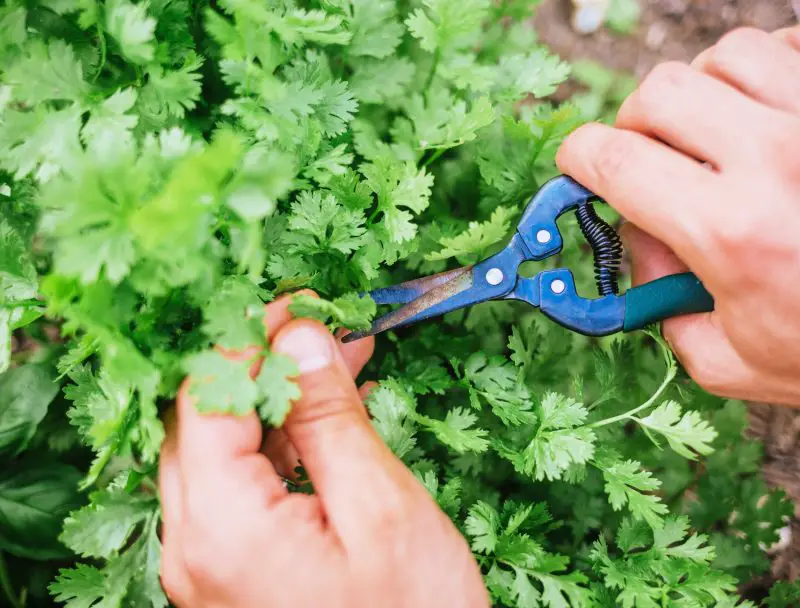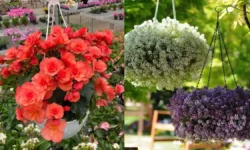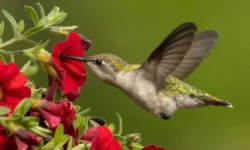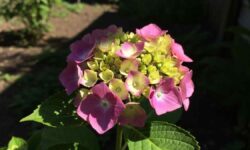Cilantro, also known as coriander in many parts of the world, is a beloved herb appreciated for its fresh, citrusy flavor that elevates countless dishes, from Mexican salsas to Asian curries. Growing cilantro at home is a rewarding experience, but harvesting it at the right moment is key to unlocking its peak flavor and ensuring a continuous supply of fresh leaves.
This comprehensive guide will walk you through the essential steps and timing to harvest cilantro perfectly, helping you enjoy its vibrant taste all season long.
Table of Contents
Understanding Cilantro Growth and Flavor Profile

Before diving into the harvesting process, it’s important to understand the growth habits and flavor dynamics of cilantro. Cilantro is a fast-growing annual herb that thrives in cooler weather. It produces delicate, lacy green leaves and eventually blooms into small white or pink flowers, followed by seed formation.
The flavor of cilantro leaves is brightest and most vibrant before the plant bolts, which means before it flowers and sets seeds. Once bolting starts, the leaves often become tougher and develop a bitter or soapy taste, which many people find unpleasant. Therefore, timing your harvest before or during early bolting is crucial to get the best-tasting cilantro.
Cilantro leaves are tender and aromatic, containing essential oils responsible for their distinct aroma and flavor. When harvested at the right time, these oils are at their peak, providing the herb’s signature fresh and zesty notes.
When Is the Right Time to Harvest Cilantro?
Timing is everything when it comes to harvesting cilantro for the best taste. Typically, cilantro is ready for harvest between 45 to 70 days after planting, depending on the growing conditions and variety.
The optimal time to harvest cilantro leaves is when the plant is about 6 to 8 inches tall and before the first signs of flowering appear. This stage ensures the leaves are tender and full of flavor.
If you wait too long and allow the plant to flower (bolt), the leaves lose their tenderness and become bitter. However, some gardeners prefer to let cilantro bolt intentionally to harvest the seeds, known as coriander, which have their own culinary uses.
Understanding the growth stage of your cilantro plants and monitoring them closely will allow you to harvest at the prime moment.
How to Harvest Cilantro Properly
Harvesting cilantro involves more than just cutting leaves. Proper technique ensures the plant continues to grow and provides fresh leaves over an extended period.
Start by inspecting the cilantro plants for the largest, healthiest leaves. These mature leaves are usually located near the base of the plant. Using sharp garden scissors or pruning shears, cut the outer leaves about 1 to 2 inches above the soil line. Avoid pulling the leaves off by hand to prevent damaging the plant.
Harvesting the outer leaves first allows the inner leaves to continue growing, promoting a longer harvest period. This method is often referred to as “cut and come again.”
Be careful not to remove more than one-third of the plant at a time, as overharvesting can stress the cilantro and reduce its overall productivity.
Regular harvesting every week or so encourages the plant to produce new foliage. Remember to leave the central growing point intact so the plant can continue thriving.
Harvesting Cilantro for Seed Production
While most gardeners focus on harvesting the fresh leaves, cilantro seeds, or coriander, are a valuable part of the plant. If you decide to let your cilantro bolt, you can harvest the seeds for use as a spice.
Once the flowers fade and seed pods begin to form, wait for them to dry on the plant. The seed pods will turn brown and become brittle. At this stage, cut the seed heads and place them in a paper bag or container to dry completely if needed.
After drying, gently crush the seed heads to release the coriander seeds. Store them in an airtight container away from direct sunlight for future use in cooking or planting.
Harvesting seeds requires patience and timing but adds versatility to your cilantro crop.
Best Time of Day to Harvest Cilantro
The time of day you harvest cilantro can affect its flavor and shelf life. For the best flavor, pick cilantro leaves early in the morning after the dew has dried but before the heat of the day sets in.
During the cooler morning hours, the essential oils that give cilantro its aroma and taste are most concentrated in the leaves. Harvesting in the heat of the afternoon can result in wilted leaves that lose flavor quickly.
After harvesting, rinse the leaves gently under cool water to remove any dirt or insects, then pat them dry with a clean towel or use a salad spinner.
Store the harvested cilantro in the refrigerator wrapped loosely in a damp paper towel inside a plastic bag or container to maintain freshness.
Tips to Extend Cilantro Harvest Season
Since cilantro prefers cooler temperatures, it tends to bolt quickly in hot weather, shortening your harvest season. To maximize your cilantro harvest, you can implement a few growing and harvesting strategies.
Plant cilantro in succession by sowing seeds every 2 to 3 weeks. This staggered planting ensures you always have young plants ready to harvest as older ones bolt.
Choose bolt-resistant cilantro varieties, which are bred to stay leafy and flavorful longer even in warmer conditions.
Provide partial shade during the hottest part of the day to slow down bolting. Mulching around the plants can help retain soil moisture and regulate temperature.
Consistent harvesting also encourages new growth, delaying flowering and extending the production of fresh leaves.
By managing your planting schedule and care practices, you can enjoy fresh cilantro for a longer time.
Common Mistakes to Avoid When Harvesting Cilantro
Even with the right timing, mistakes in harvesting techniques can impact your cilantro’s flavor and longevity.
One common error is harvesting too late, after the plant has bolted. This results in bitter, tough leaves that detract from dishes.
Another mistake is cutting the entire plant at once. This removes the growing tips and prevents regrowth, shortening your harvest period.
Pulling leaves instead of cutting can damage the plant’s roots and stems, causing stress or death.
Also, failing to harvest regularly may encourage the plant to bolt sooner, as it shifts energy into flowering and seed production.
Avoiding these pitfalls will help maintain healthy plants and flavorful leaves.
How to Store Harvested Cilantro for Maximum Freshness
Once harvested, cilantro is highly perishable and requires proper storage to maintain its bright flavor.
After washing and drying, wrap the cilantro loosely in a damp paper towel. Place the wrapped herbs inside a resealable plastic bag or airtight container, leaving a small opening for airflow.
Store cilantro in the vegetable crisper drawer of your refrigerator, where the temperature and humidity are ideal for leafy greens.
Alternatively, you can store cilantro stems in a glass of water covered loosely with a plastic bag, changing the water every couple of days.
For longer storage, consider freezing cilantro by chopping the leaves and placing them in ice cube trays with a bit of water or olive oil, then transferring the frozen cubes to freezer bags.
Proper storage preserves the freshness and flavor, allowing you to enjoy cilantro even when it’s not in season.
Culinary Uses of Freshly Harvested Cilantro
Fresh cilantro is a versatile herb that complements a wide variety of cuisines and dishes. Its bright, citrusy notes bring life to salsas, guacamole, and fresh salads.
It is commonly used as a garnish for soups, curries, and tacos, adding a fresh aroma and vibrant green color.
In Asian cooking, cilantro leaves are often added at the end of cooking to retain their flavor and freshness.
Because cilantro flavor can diminish quickly when cooked for long periods, it’s best added just before serving.
Harvesting cilantro at the right time ensures the best flavor for these culinary applications.
FAQs About How to Harvest Cilantro
When is the best time to harvest cilantro for maximum flavor?
The best time to harvest cilantro is when the plant reaches 6-8 inches tall and before it starts flowering to ensure tender, flavorful leaves.
How do I harvest cilantro without damaging the plant?
Use sharp scissors to cut the outer leaves about 1-2 inches above the soil, leaving the inner leaves to keep growing.
Can I harvest cilantro seeds from the same plant?
Yes, after the plant flowers and the seed pods dry, you can collect coriander seeds for cooking or planting.
How often should I harvest cilantro to keep it growing?
Harvest cilantro regularly, about once a week, but avoid cutting more than one-third of the plant at a time to encourage continuous growth.
What is the best way to store freshly harvested cilantro?
Wrap cilantro loosely in a damp paper towel, place it in a plastic bag, and refrigerate to keep it fresh longer.
Conclusion: Mastering the Art of Harvesting Cilantro
Harvesting cilantro at the right time is essential to enjoy its best taste and maintain a productive herb garden. By understanding cilantro’s growth cycle, harvesting leaves before bolting, and using proper cutting techniques, you can savor fresh, flavorful cilantro all season.
Regular, gentle harvesting encourages new growth, while proper storage techniques keep your cilantro fresh longer.
Whether you are a seasoned gardener or a culinary enthusiast, mastering the timing and method of harvesting cilantro will elevate your cooking and gardening experience.
Embrace the process, and enjoy the delightful aroma and taste of freshly harvested cilantro in your kitchen.






